A few days ago, WD broke their silence on the WD Red DM-SMR and charted a new course. We received a late afternoon e-mail about a blog post going up and promptly got a piece up discussing the big WD Red Plus Launch news. Some noted that we did three previous articles on the use of DM-SMR along with three videos yet for that article, just given the time constraint, we did not do a video. Today, in a Sunday gearing up for a holiday week, we have that video.
What WD Red Plus Means For the Industry Video
Here is the video that is going along with this piece.
In a slight break from tradition, we are only going to cover some of the new incremental bits in this article, while we are going to refer you to the previous article for some of the initial impressions. We try keeping parity but this is going to be a case where the video ties to two articles, one is the below. Since some time passed between the announcement and the video, we did have a few thoughts to add that made it to the video, but not the original article.
What WD Red Plus Launched and Impact
Let us start with the foundation. After some pointed feedback from the online community on hard drive vendors Surreptitiously Swapping SMR into Hard Drive Lines, we decided to test to see if there is an impact to NAS users. Will’s piece WD Red SMR vs CMR Tested Avoid Red SMR clearly showed why one does not want the new DM-SMR technology for heavier use cases, especially ZFS. In our WD Red DM-SMR Update 3 we found evidence that WD knew, or should have known, that DM-SMR was not appropriate for the NAS market. Likewise, we saw vendors purge the Red drives from their compatibility lists.
On April 22, WD noted that its 2-6TB “EFAX” drives were DM-SMR, while the remainder of its “EFAX” drives were traditional CMR drives that perform well. Over two months later, WD finally gave some clarity by re-aligning its portfolio to put the lower capacity EFRX drives along with the higher capacity EFAX/ EFFX drives into a new WD Red Plus line. At the same time, the WD Red line now holds the four 2-6TB EFAX drives that use DM-SMR. This new branding is important.
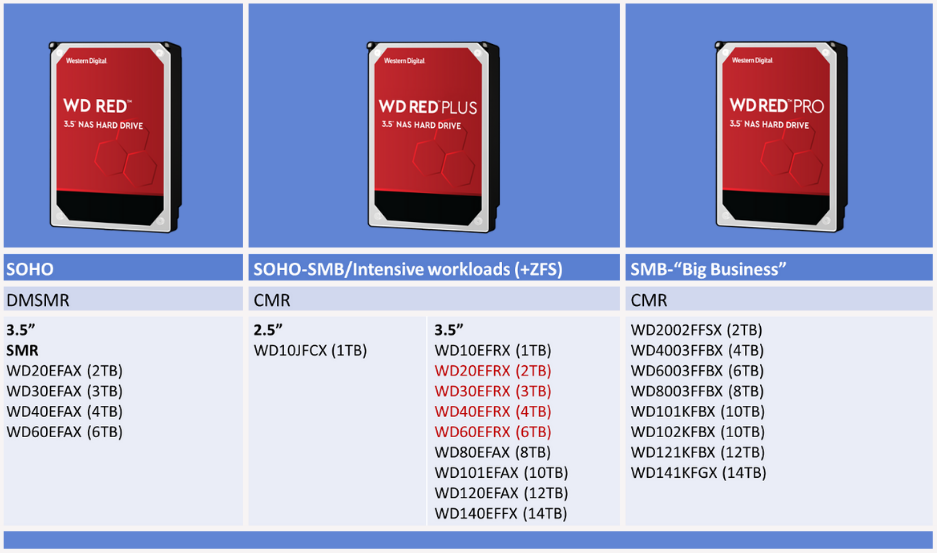
By moving the DM-SMR drives into the main “WD Red” line, WD now has a very small WD Red portfolio in the root brand. The “WD Red” line has a lot of brand equity. Notably, instead of using the CMR drives as WD Red restoring that brand to former glory, it has now pushed CMR into Red Plus. One could argue that WD is signaling that it is set to fill out the WD Red line with larger options once again, likely using DM-SMR technology. It also leaves the CMR “Red Plus” brand in an easy position to rationalize in the future. If three lines are too many, it is easier to remove the new Red Plus brand versus the traditional Red brand.
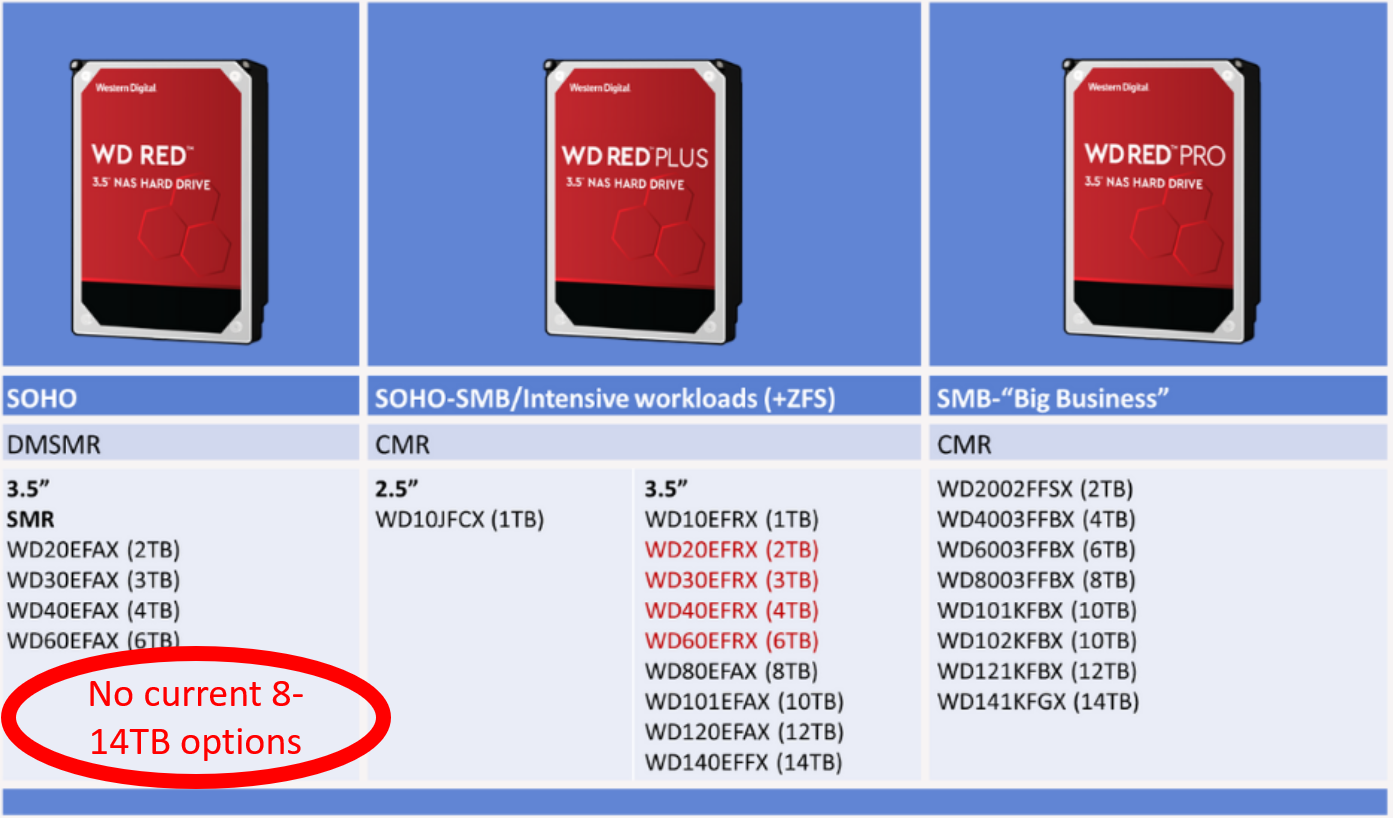
One will notice, that although WD failed to cite their source for third-party testing, the WD Red Plus is now focused on SOHO-SMB/ Intensive workloads (+ZFS.) It is likely that WD is referencing our work and Jim Salter’s work at Arstechica on ZFS and DM-SMR. That brings us to an interesting sequence of events.
WD Red DM-SMR Illustrative Sequence
We put some key events, certainly far from all of them, in chronological order. Since the scale was going to be a challenge given the first event was years before the other events that all happened in a single quarter, we are calling this an “illustrative sequence” not a timeline. Still, here are some key events:
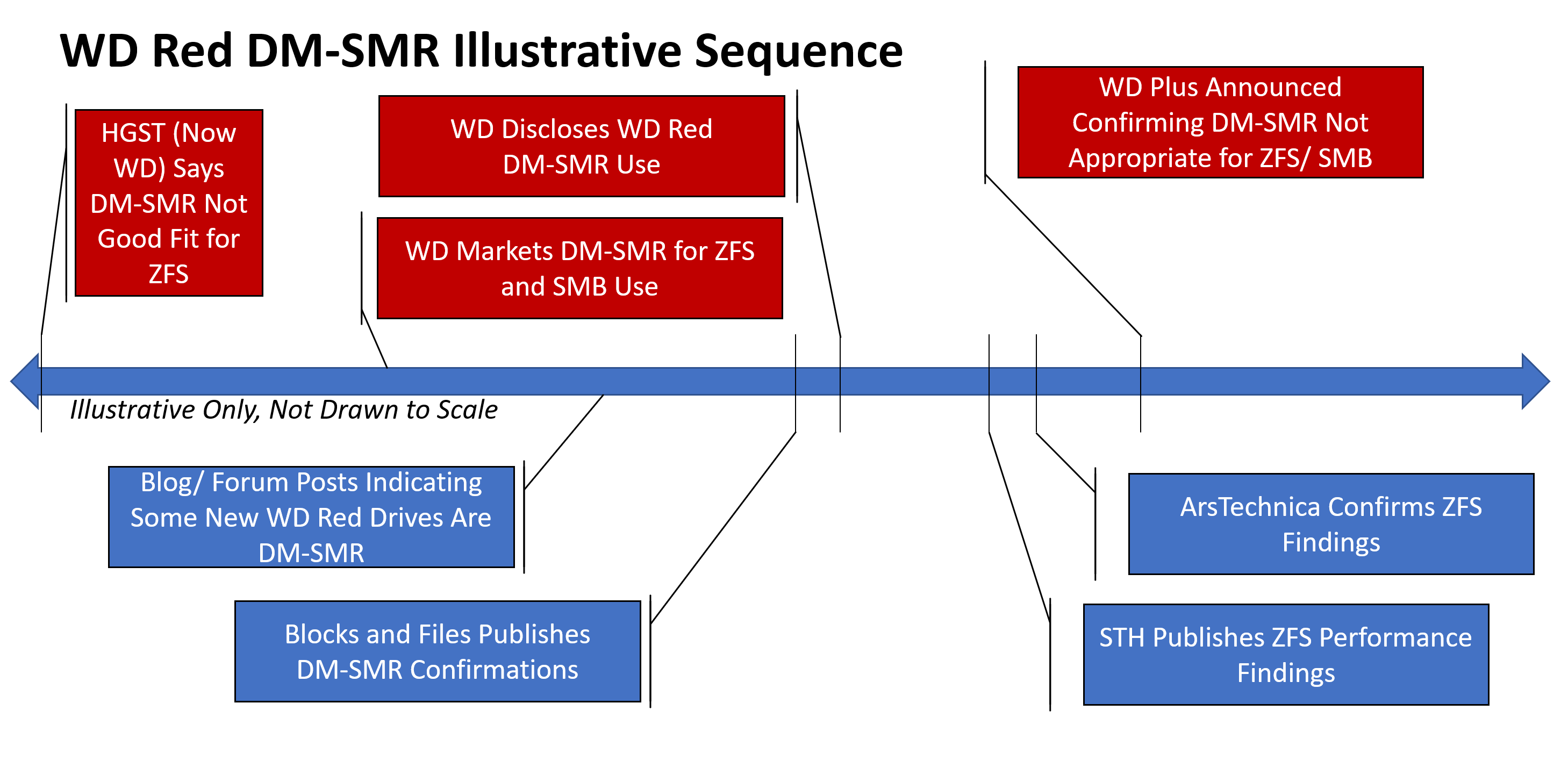
A big impact here is that WD, by stating that the same drives it is currently selling as WD Red drives for SOHO and SMB markets, has effectively conceded that its touted testing was not thorough enough to catch that the DM-SMR drives were not fit for the purpose of being used in SMB/ intensive/ ZFS workloads. This actually a great step, however, one must also remember that it took WD almost a month from when we published our findings to introduce the new alignment.
On the subject of a month, while the media, including myself, has latched onto the new drive alignment, there is something potentially important. WD, even after making this concession, is still marketing DM-SMR drives and CMR drives alongside one another in the WD Red brand on their product pages. Here is a snap just before the article and video went live from the company’s site accessed 2020-06-28:
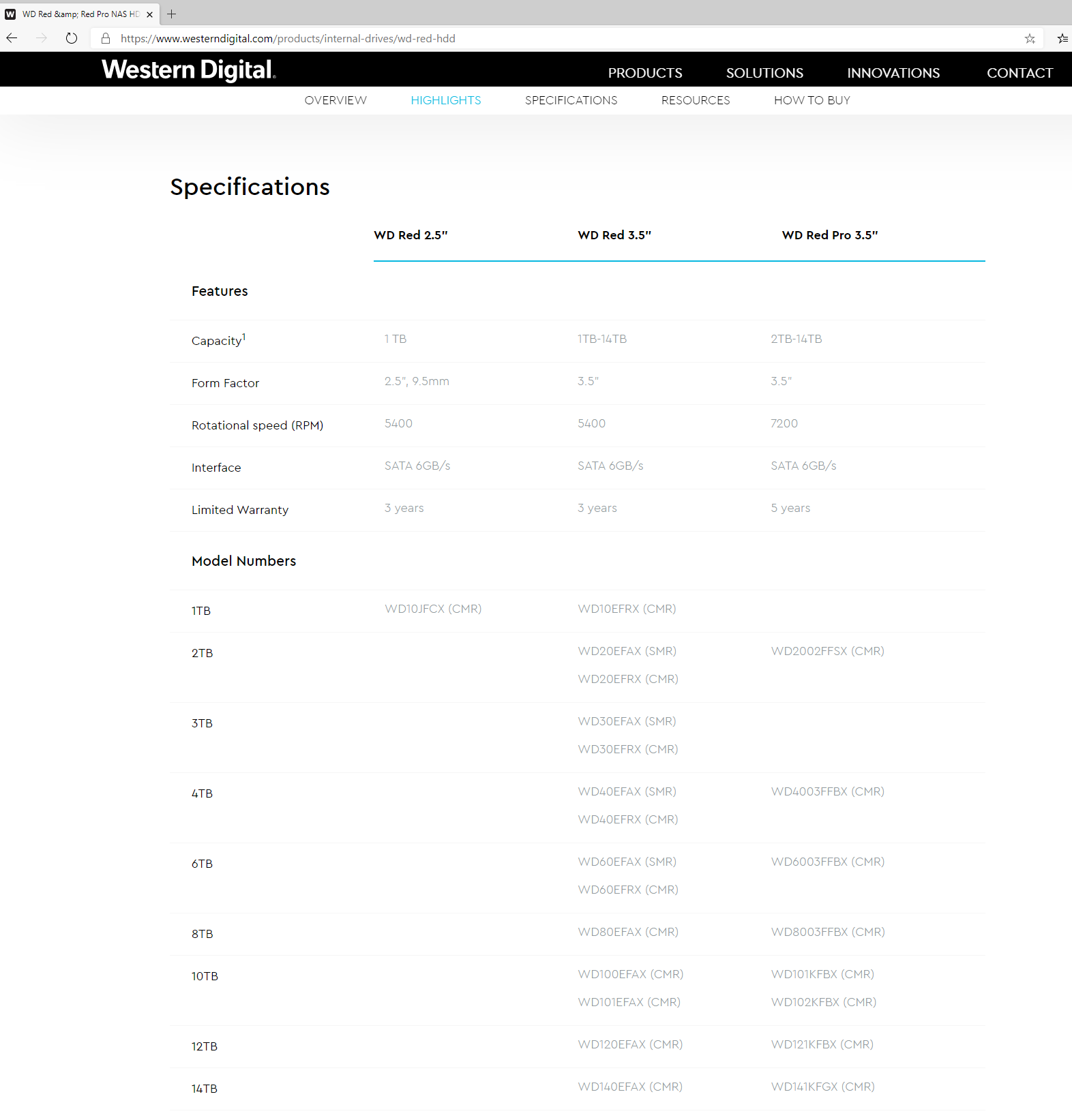
While WD is scoring wins, as they should, for acknowledging that they were selling drives unfit for the purpose they were marketed for, they are still actively selling their current stock without this new alignment.
This will surely change, and perhaps five days (or over two months depending on when you start the timing) is not enough time to update marketing materials. Still, someone purchasing a drive today, only using WD’s marketing materials and official spec pages instead of the WD Blog, would not know that WD has changed its product positioning in terms of what the drives are fit to be used for.
Impact Beyond WD
Given the relatively high barrier to entry into this market, declining volumes, and lack of intense competition, the movement of WD Red to a DM-SMR has another impact. WD is effectively setting up a situation where it can now, completely transparently, market DM-SMR technology in the WD Red line using a three-level approach. For Toshiba and Seagate, they now face a quandary. If they do not introduce a matching structure, WD will be selling its Red drives using DM-SMR at higher margins due to DM-SMR cost savings. They will be under intense pressure to match this structure.
Final Words
The danger for consumers by moving DM-SMR into the “WD Red” brand is that consumers who either do not have other options or do not understand the difference will continue to buy WD Red. After all, if you have been using WD Red for five years, then just buying another WD Red is a reflexive decision. Other markets may not have the means nor the opportunity to buy Red Plus drives, especially as they are not available, even on the WD website’s product pages today.
WD is doing the right thing by bifurcating lines between DM-SMR and CMR variants. Also, credit must be given to the company for ensuring this information is clearly disclosed. By keeping DM-SMR in the main WD Red brand, it is up to our readers to educate those in the community who are less up-to-date on the field as to the impact of this change. For many, the WD Red Plus will be the best option to give previous-gen performance characteristics in the WD Red line.

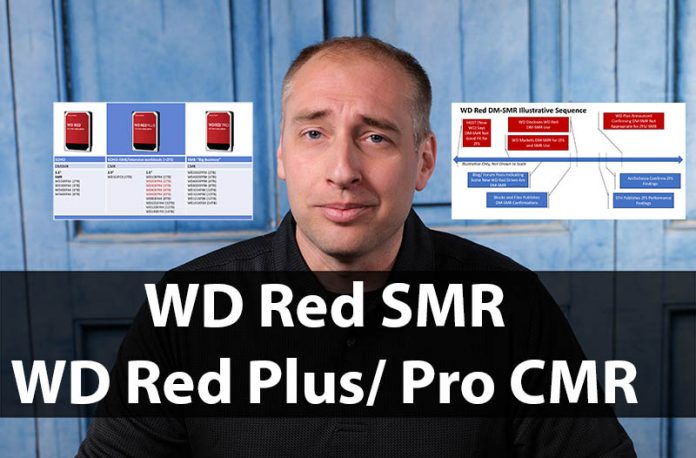



At least there’s new stuff here! I liked the discussion on product lines and alignment across the industry.
I have only WD Red drives in my servers (several dozen drives). I had planned on buying another eight WD Red drives for a storage upgrade, but WD has completely lost my trust. They are now my last choice for drives. It’ll likely be many years before I buy a WD drive again, unless the other vendors do something even more untrustworthy.
I had been using WD Red drives for a deployment model I have been using at work. I have had 0 issues with them, dozens of drives yielded 0 infant mortality and about 6 month in are spinning along fine.. Their QA was really spot on. When I first heard this news I was really quite sad because my deployment relies on ZFS. The fact that WD withheld this information initially and is now releasing a new product line is tantamount to admitting guilt. I was always a loyal WD customer, before the HGST acquisition and even more fervently after. My trust has waned, however. Unless I am purchasing datacenter drives, I don’t think I will look at WD any longer, and even then it won’t be up to me because it’ll be whatever the system integrators choose.
I recently needed to purchase about $15k worth of drives for the project I am working on. Because of this whole situation, I went out to bid for Seagate Ironwolf drives instead and I will be taking delivery of them this week.
Transparency is not WD believes. Remember IntelliRPM which is actually 5400 RPM shxt they don’t want to tell?
it is so confusing. EFAX 6tb and lower is SMR. EFAX 8tb and higher is CMR.
why not making the whole EFAX-serie SMR, just for simplicity and easy overview ??
If they were honest, they would’ve added another color for reduced performance better value. Unused colors in related families include: beige, bronze, mauve, burgundy, burnt siena. Make it a bit like the muddled color of your watercolor cleaning cup after using too many brushes. That would be honest.
In the article Timeline, one item states, that “WD markets RED drives for ZFS use”, can you provide any examples of this? I know that many people have used WD REDs for ZFS, but I’ve actually never seen WD advertise the drives for such use
Simon – ZFS is a popular NAS filesystem. Partners were selling systems with Red DM-SMR drives based on support from WD. The iXsystems FreeNAS Mini systems are prime examples where these drives were sold and documented as ZFS systems with WD drives.
I’m thinking you’re being far too gentle on them. Except in that blog, like you show, they’re still marketing drives without the Plus distinction. It’s like they made a half-baked announcement.
WD needs to hire Patrick as VP-GM of WD Red to clean this up. They’d have a name and a face to show a commitment to do better.
I hope they don’t though. STH is far too good of an industry resource.
As the originator of the media storm that got this all rolling:
“Too little, too late” – and it won’t stop the class actions or the consumer protection investigations now underway around the world
By taking a markedly inferior product and using an existing branding on it (RED) whilst rebranding the existing product to a premium (RED+), WD have crossed a bait-and-switch line that’s never been crossed in this market before
My old 1994 4GB firebreathing banshee Barracuda drives were premium – and a 2015(pre SMR) Barracuda drive was economy, however that 2015 drive still outperformed the 1994 one
Likewise the higher end CPUs of olde may become low end CPUs today, but those low end CPUs still outperform their older brethren of the same name
There’s only a 4% difference showing on Insight UK’s price list between RED and RED+
Nobody who knows what’s going on will touch the RED devices at that price difference with a risk of 30-99.8% performance impact
Consumers who’ve only ever read glowing RED reviews won’t know and will get BURNED. None of the older reviews will be removed, but they’re no longer applicable.
This is the essence of bait-and-switch writ large. If WD had rebranded the SMR drives as PINK or ORANGE we wouldn’t be having this discussion.
The only consolation is that they can’t jack up prices. SSDs are breaching heavily down their necks(*)
What’s come out is a huge breach of trust by all three makers and arguably hastened their demise – after 9 years of enduring artficially inflated pricing (and slashed warranties!) post 2011 Thai floods then being played for suckers, who in their right mind is going to keep giving these companies their custom for one second longer than necessary?
(*) 180TB/year is about 0.22drive writes or READS per day on a 4TB RED/N300/Ironwolf (0.12D[RW]PD on 8TB drives)
– and the extra cache tossing of the SMRs gets added to this wear figure.
Micron’s ION _enterprise_ SATA SSD range are currently 3 times the price of these devices, have a 5 year warranty and 0.2DWPD minimum (4KB randomw writes – rising to 0.8DWPD for 1MiB writes)
reads are “free” on SSDs and these things use 1/4 the power of a RED’s 6W
Like other commenters: WD (and Seagate) have already lost business because of this.
My employer no longer puts spinning media in desktop systems, nor do we buy WD/Seagate SSDs.
I’m in the process of pivoting away from spinners entirely in our Petabyte class storage systems and looking _very_ carefully at who gets my next purchase – which has about $180,000 of hard drives in it – it will probably be the very last storage system with mechanical drives in it and even that’s under protest as moving to SSDs in the core _now_ would allow cost savings on the network edge that outweigh the extra costs.
IOW, RED+ means nothing. It’s a scam. Marketing i has invented a plus version just to hide inferior product line within previously esablished series name.
Whoever came up with that idea shoudl be shot, along with his kids for safety margin.
Patrick, thank you very much for this coverage.
I write here quite a long time after original article, but just saw that WD Reds are still prominently in your Top Picks for FreeNAS Hard Drives. You might want to update that material, with at least a few links here.
Thank you a lot!
WD should be crucified for trying to pull off a scam like this! And they didnt even have the decency to delete these DMR drives from their Red (NAS) line, instead still trying to pull one over on their buying public. No more WD drives for me!